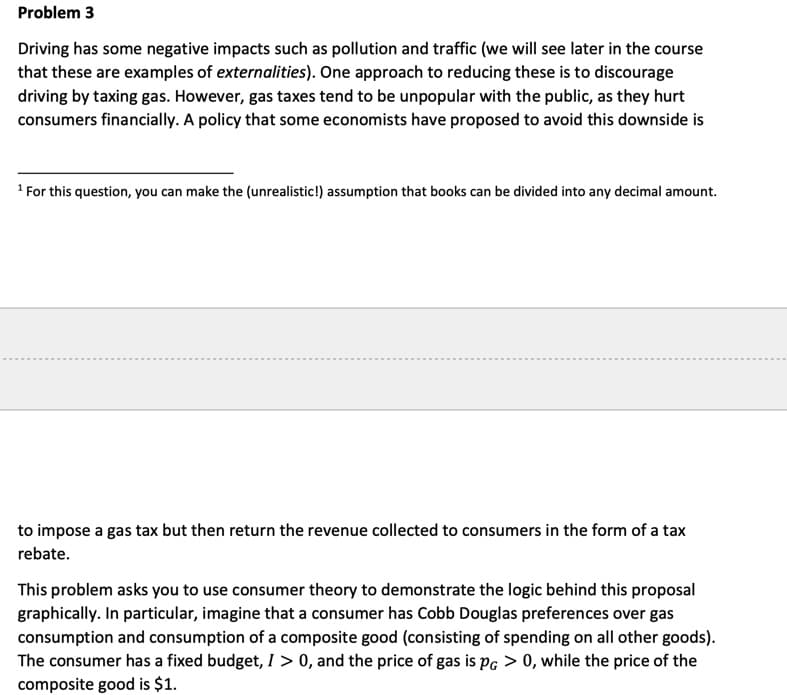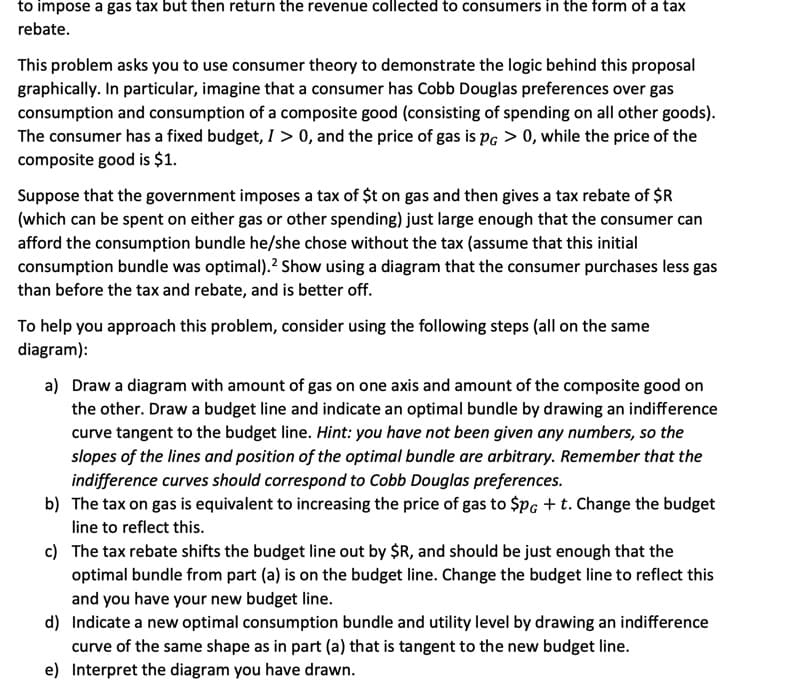Problem 3 Driving has some negative impacts such as pollution and traffic (we will see later in the course that these are examples of externalities). One approach to reducing these is to discourage driving by taxing gas. However, gas taxes tend to be unpopular with the public, as they hurt consumers financially. A policy that some economists have proposed to avoid this downside is ' For this question, you can make the (unrealistic!) assumption that books can be divided into any decimal amount. to impose a gas tax but then return the revenue collected to consumers in the form of a tax rebate. This problem asks you to use consumer theory to demonstrate the logic behind this proposal graphically. In particular, imagine that a consumer has Cobb Douglas preferences over gas consumption and consumption of a composite good (consisting of spending on all other goods). The consumer has a fixed budget, I > 0, and the price of gas is pg > 0, while the price of the
Problem 3 Driving has some negative impacts such as pollution and traffic (we will see later in the course that these are examples of externalities). One approach to reducing these is to discourage driving by taxing gas. However, gas taxes tend to be unpopular with the public, as they hurt consumers financially. A policy that some economists have proposed to avoid this downside is ' For this question, you can make the (unrealistic!) assumption that books can be divided into any decimal amount. to impose a gas tax but then return the revenue collected to consumers in the form of a tax rebate. This problem asks you to use consumer theory to demonstrate the logic behind this proposal graphically. In particular, imagine that a consumer has Cobb Douglas preferences over gas consumption and consumption of a composite good (consisting of spending on all other goods). The consumer has a fixed budget, I > 0, and the price of gas is pg > 0, while the price of the
Principles of Microeconomics
7th Edition
ISBN:9781305156050
Author:N. Gregory Mankiw
Publisher:N. Gregory Mankiw
Chapter22: Frontiers Of Microeconomics
Section: Chapter Questions
Problem 6PA
Related questions
Question

Transcribed Image Text:Problem 3
Driving has some negative impacts such as pollution and traffic (we will see later in the course
that these are examples of externalities). One approach to reducing these is to discourage
driving by taxing gas. However, gas taxes tend to be unpopular with the public, as they hurt
consumers financialy. A policy that some economists have proposed to avoid this downside is
' For this question, you can make the (unrealistic!) assumption that books can be divided into any decimal amount.
to impose a gas tax but then return the revenue collected to consumers in the form of a tax
rebate.
This problem asks you to use consumer theory to demonstrate the logic behind this proposal
graphically. In particular, imagine that a consumer has Cobb Douglas preferences over gas
consumption and consumption of a composite good (consisting of spending on all other goods).
The consumer has a fixed budget, I > 0, and the price of gas is pg > 0, while the price of the
composite good is $1.

Transcribed Image Text:to impose a gas tax but then return the revenue collected to consumers in the form of a tax
rebate.
This problem asks you to use consumer theory to demonstrate the logic behind this proposal
graphically. In particular, imagine that a consumer has Cobb Douglas preferences over gas
consumption and consumption of a composite good (consisting of spending on all other goods).
The consumer has a fixed budget, I > 0, and the price of gas is pg > 0, while the price of the
composite good is $1.
Suppose that the government imposes a tax of $t on gas and then gives a tax rebate of $R
(which can be spent on either gas or other spending) just large enough that the consumer can
afford the consumption bundle he/she chose without the tax (assume that this initial
consumption bundle was optimal).? Show using a diagram that the consumer purchases less gas
than before the tax and rebate, and is better off.
To help you approach this problem, consider using the following steps (all on the same
diagram):
a) Draw a diagram with amount of gas on one axis and amount of the composite good on
the other. Draw a budget line and indicate an optimal bundle by drawing an indifference
curve tangent to the budget line. Hint: you have not been given any numbers, so the
slopes of the lines and position of the optimal bundle are arbitrary. Remember that the
indifference curves should correspond to Cobb Douglas preferences.
b) The tax on gas is equivalent to increasing the price of gas to $pg + t. Change the budget
line to reflect this.
c) The tax rebate shifts the budget line out by $R, and should be just enough that the
optimal bundle from part (a) is on the budget line. Change the budget line to reflect this
and you have your new budget line.
d) Indicate a new optimal consumption bundle and utility level by drawing an indifference
curve of the same shape as in part (a) that is tangent to the new budget line.
e) Interpret the diagram you have drawn.
Expert Solution
This question has been solved!
Explore an expertly crafted, step-by-step solution for a thorough understanding of key concepts.
This is a popular solution!
Trending now
This is a popular solution!
Step by step
Solved in 2 steps with 1 images

Recommended textbooks for you

Principles of Microeconomics
Economics
ISBN:
9781305156050
Author:
N. Gregory Mankiw
Publisher:
Cengage Learning

Exploring Economics
Economics
ISBN:
9781544336329
Author:
Robert L. Sexton
Publisher:
SAGE Publications, Inc

Principles of Economics 2e
Economics
ISBN:
9781947172364
Author:
Steven A. Greenlaw; David Shapiro
Publisher:
OpenStax

Principles of Microeconomics
Economics
ISBN:
9781305156050
Author:
N. Gregory Mankiw
Publisher:
Cengage Learning

Exploring Economics
Economics
ISBN:
9781544336329
Author:
Robert L. Sexton
Publisher:
SAGE Publications, Inc

Principles of Economics 2e
Economics
ISBN:
9781947172364
Author:
Steven A. Greenlaw; David Shapiro
Publisher:
OpenStax